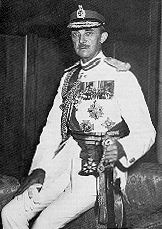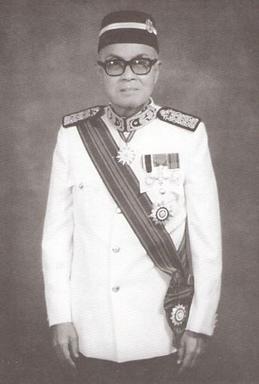
Guerrilla warfare is a form of unconventional warfare in which small groups of irregular military, such as rebels, partisans, paramilitary personnel or armed civilians including recruited children, use ambushes, sabotage, terrorism, raids, petty warfare or hit-and-run tactics in a rebellion, in a violent conflict, in a war or in a civil war to fight against regular military, police or rival insurgent forces.

The Malayan Emergency, also known as the Anti–British National Liberation War(1948–1960), was a guerrilla war fought in British Malaya between communist pro-independence fighters of the Malayan National Liberation Army (MNLA) and the military forces of the Federation of Malaya, British Empire and Commonwealth. The communists fought to win independence for Malaya from the British Empire and to establish a socialist economy, while the Malayan Federation and Commonwealth forces fought to combat communism and protect British economic and colonial interests. The term "Emergency" was used by the British to characterise the conflict in order to avoid referring to it as a war, because London-based insurers would not pay out in instances of civil wars.

Search and destroy is a military strategy which consists of inserting infantry forces into hostile territory and directing them to search and then attack enemy targets before immediately withdrawing. First used as part of counterinsurgency operations during military conflicts in Southeast Asia such as the Malayan Emergency and the Vietnam War, the strategy was developed to take advantage of new technological capabilities available to Western militaries such as the helicopter, which allowed for the adoption of new tactics like the air assault.

An insurgency is a violent, armed rebellion by small, lightly armed bands who practice guerrilla warfare from primarily rural base areas against a larger authority. The key descriptive feature of insurgency is its asymmetric nature: small irregular forces face a large, well-equipped, regular military force state adversary. Due to this asymmetry, insurgents avoid large-scale direct battles, opting instead to blend in with the civilian population where they gradually expand territorial control and military forces. Insurgency frequently hinges on control of and collaboration with local populations.
Sir Robert Grainger Ker Thompson (1916–1992) was a British military officer and counter-insurgency expert who "was widely regarded on both sides of the Atlantic as the world's leading expert on countering the Mao Tse-tung technique of rural guerrilla insurgency". His 1966 book Defeating Communist Insurgency played an important role in popularizing the "hearts and minds" approach to counterinsurgency.

Field Marshal Sir Gerald Walter Robert Templer, was a senior British Army officer. He fought in both the world wars and took part in the crushing of the Arab Revolt in Palestine. As Chief of the Imperial General Staff, the professional head of the British Army between 1955 and 1958, Templer was Prime Minister Anthony Eden's chief military adviser during the Suez Crisis. He is also credited as a founder of the United Kingdom's National Army Museum.

Jungle warfare or woodland warfare is warfare in forests, jungles, or similar environments. The term encompasses military operations affected by the terrain, climate, vegetation, and wildlife of densely-wooded areas, as well as the strategies and tactics used by military forces in these situations and environments.

Counterinsurgency is "the totality of actions aimed at defeating irregular forces". The Oxford English Dictionary defines counterinsurgency as any "military or political action taken against the activities of guerrillas or revolutionaries" and can be considered war by a state against a non-state adversary. Insurgency and counterinsurgency campaigns have been waged since ancient history. However, modern thinking on counterinsurgency was developed during decolonization.

Hearts and Minds or winning hearts and minds refers to the strategy and programs used by the governments of Vietnam and the United States during the Vietnam War to win the popular support of the Vietnamese people and to help defeat the Viet Cong insurgency. Pacification is the more formal term for winning hearts and minds. In this case, however, it was also defined as the process of countering the insurgency. Military, political, economic, and social means were used to attempt to establish or reestablish South Vietnamese government control over rural areas and people under the influence of the Viet Cong. Some progress was made in the 1967–1971 period by the joint military-civilian organization called CORDS, but the character of the war changed from a guerrilla war to a conventional war between the armies of South and North Vietnam. North Vietnam won in 1975.

The Briggs Plan was a military plan devised by British General Sir Harold Briggs shortly after his appointment in 1950 as Director of Operations during the Malayan Emergency (1948–1960). The plan aimed to defeat the Malayan National Liberation Army by cutting them off from their sources of support amongst the rural population. To achieve this a large programme of forced resettlement of Malayan peasantry was undertaken, under which about 500,000 people were forcibly transferred from their land and moved to concentration camps euphemistically referred to as "new villages".

David Galula was a French military officer and scholar who was influential in developing the theory and practice of counterinsurgency warfare.

The Malayan National Liberation Army (MNLA), often mistranslated as the Tentera Pembebasan Kebangsaan Malaya, was a communist guerrilla army that fought for Malayan independence from the British Empire during the Malayan Emergency (1948–1960) and later fought against the Malaysian government in the Communist insurgency in Malaysia (1968–1989). Their central committee was a trade union activist known as Chin Peng who had previously been awarded an OBE by the British for waging a guerrilla war against the Japanese occupation of Malaya. Many MNLA fighters were former members of the Malayan Peoples' Anti-Japanese Army (MPAJA) which had been previously trained and funded by the British to fight against Japan during the Second World War.

Too Chee Chew (杜志超 M.B.E., better known as C. C. Too, was a major exponent of psychological warfare in Malaysia.

The British Military Administration (BMA) was the interim administrator of British Malaya from August 1945, the end of World War II, to the establishment of the Malayan Union in April 1946. The BMA was under the direct command of the Supreme Allied Commander South East Asia, Lord Louis Mountbatten. The administration had the dual function of maintaining basic subsistence during the period of reoccupation, and also of imposing the state structure upon which post-war imperial power would rest.

David John Kilcullen FRGS is an Australian author, strategist, and counterinsurgency expert who is currently the non-executive chairman of Caerus Associates, a strategy and design consulting firm that he founded. He is a professor at Arizona State University and at University of New South Wales, Canberra.
The main strategy and tactics of guerrilla warfare tend to involve the use of a small attacking, mobile force against a large, unwieldy force. The guerrilla force is largely or entirely organized in small units that are dependent on the support of the local population. Tactically, the guerrilla army makes the repetitive attacks far from the opponent's center of gravity with a view to keeping its own casualties to a minimum and imposing a constant debilitating strain on the enemy. This may provoke the enemy into a brutal, excessively destructive response which will both anger their own supporters and increase support for the guerrillas, ultimately compelling the enemy to withdraw. One of the most famous examples of this was during the Irish War of Independence. Michael Collins, a leader of the Irish Republican Army, often used this tactic to take out squads of British soldiers, mainly in Munster, especially Cork.
The Special Operations Volunteer Force was a special program developed by the British and Malayan authorities during the Malayan Emergency. The unit existed from 1952 until the end of the Emergency in 1960.
Clear and hold is a counter-insurgency strategy in which military personnel clear an area of guerrillas or other insurgents, and then keep the area clear of insurgents while winning the support of the populace for the government and its policies. As defined by the United States Army, "clear and hold" contains three elements: civil-military operations, combat operations, and information warfare. Only highly strategic areas are initially chosen for "clear and hold" operations; once they are secure, the operation gradually spreads to less strategic areas until the desired geographic unit is under control. Once an area has been cleared, local police authority is re-established, and government authority re-asserted.

Southern Rhodesia, then a self-governing colony of the United Kingdom, sent two military units to fight with the Commonwealth armed forces in the Malayan Emergency of 1948–60, which pitted the Commonwealth against the Malayan National Liberation Army (MNLA), the military arm of the Malayan Communist Party. For two years, starting in March 1951, white Southern Rhodesian volunteers made up "C" Squadron of the Special Air Service (SAS). The Rhodesian African Rifles, in which black rank-and-filers and warrant officers were led by white officers, then served in Malaya from 1956 to 1958.
Karl Anthony Hack is a British historian and academic, who specialises in the history of Southeast Asia, the British Empire, and of insurgency and counter-insurgency. Drawing on interviews with insurgents, his work has demonstrated the role of high-level coercion in winning post-war counter-insurgencies, and explored extreme violence and violence limitation. He has also carried out a wide range of public work, ranging across heritage, memory, the media and the courts. He is a professor of history at The Open University where he has also been head of history, and head of the School of History, Religious Studies, Sociology, Social Policy and Criminology. Prior to joining The Open University in 2006, he taught at the National Institute of Education, at Singapore's Nanyang Technological University, from 1995 to 2006.
















